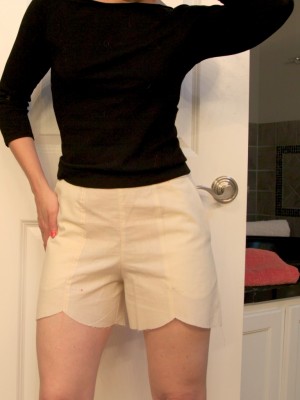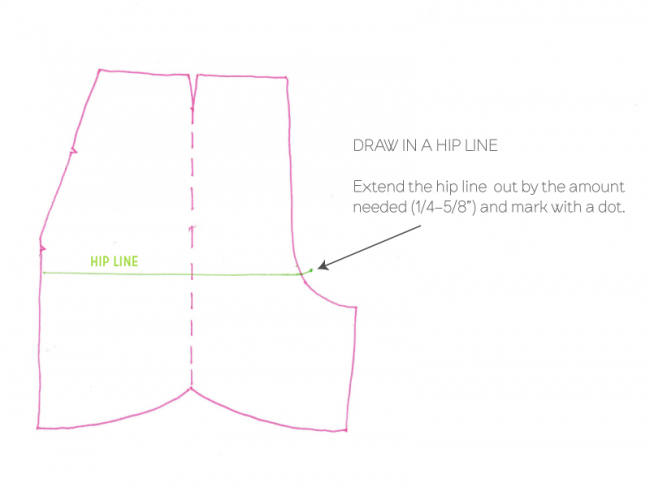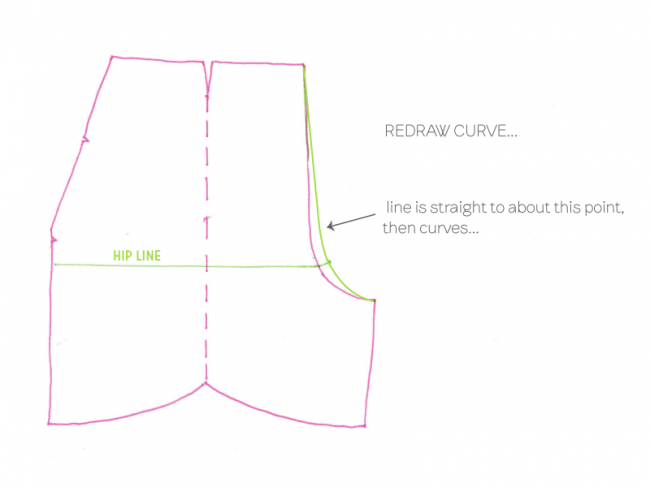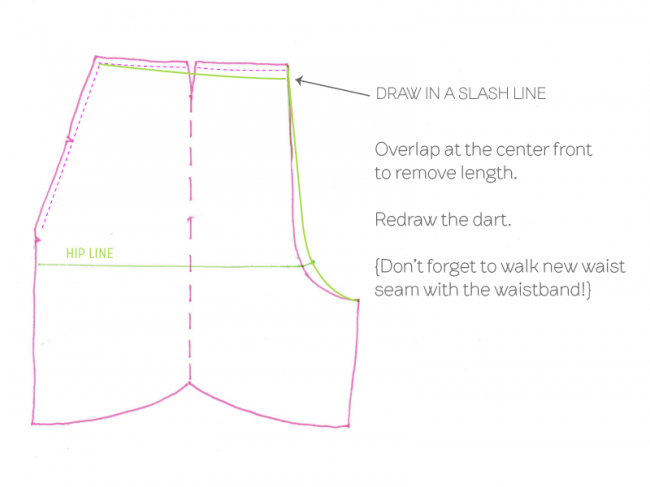Howdy all, hope you’re having a beautiful week! We’ve been having mad storms here the last couple of days, and hallelujah, I’m so happy it’s raining. Our dogs, on the other hand, get nervy with all the thunder and lightning, and last night the youngest one bolted out of our gate, disappearing for SIX hours. Nothing like running around in Texas-sized tree-felling winds, yelling out “JAKEY WAKEY!” all over the neighborhood (Jakob, Jake, Jakey, Lanky Jakey…)! Turns out he found his way to our friend’s house several blocks away to huddle on the porch–smart border collie.
Anyways, a few readers asked for a visual of how I adjusted the front rise of my scallop shorts so I used a little rainy day to put together a pictorial. I know it’s hard to explain those things in words! I dug out my muslin to give you an idea of what was going on. I don’t know what was going on with this pose, my awkwardest attempt to keep the side seams closed while simultaneously keeping my arms out of the picture:
 Unfortunately, I adjusted my muslin before I could get pics, but this is what it looked like after doing a minor version of my adjustment–you can see the residual problem and it got even better after I did more adjusting.
Unfortunately, I adjusted my muslin before I could get pics, but this is what it looked like after doing a minor version of my adjustment–you can see the residual problem and it got even better after I did more adjusting.
Problems:
* Front rise is too long (hence the horizontal folds or droopiness).
* The curve or dip point of the front crotch seam stands too far away from the body. The radiating folds that extend from it feel restricting.
It seemed the folding was due to both excess vertical length AND stress from being too tight around the hips. So here’s what I did:

1. Drew in a hip line. There wasn’t one on my pattern, but I marked the spot on the center front of my muslin where the fold was, and used that as the hip line.
2. Then I extended the hipline about 1/2-5/8″ from the original edge and marked a dot. I tested this by re-sewing the curve 1/4″ into the seam allowance on my muslin, then re-drew it further out for the final version.
(If you want to get really precise, you can mark in the seam lines, and measure out from that line, then re-draw the seam allowances.)

3. Then I re-drew the curve to meet that dot. The curve is now shallower, which also makes it shorter. You can also see that the front hip width has now gotten wider as a result. By re-drawing that curve, I gave myself about an inch total more hip room.

4. I still had a bit of excess length in the front so I took out a wedge along the waistline, about 3/8″, starting at center front and tapering to nothing at the side seam.
I’m pretty happy with the way it all turned out! Has anyone else battled this kind of fit issue? I’d love to hear what has worked for you.
I hope that helps!
Would you like tips and inspiration in the craft of lingerie sewing? Sign up for my weekly eletter The Lingerie Maker.

That is really helpful. Thank you for taking the time. I am more willing to give these a try.
thank you! this is a great little tutorial. There are such a myriad of little things that can go wrong with crotch seams, so its always good to have more solutions in my back pocket!
I know, right? I have so much to learn…
These shorts are going to be so cute! Love the hem treatment.
Hi Meg! These are really fun shorts–I actually made them in a twill from Mood (so glad to see you blogging there–I missed your old blog!).
Saving these tips… thanks!
Your illustrations are really cool looking. Way different than my illustrations that I make in Illustrator. It’s really interesting that you added hip width at the front rise. When I first read it, I thought you would add it at the SS but realized that the folds/stress lines were coming from the rise. It just goes to show that one pattern alteration can be done many ways. LOVE. THIS. HOBBY.
I love it too! And when simple fixes just work out! Thanks on the illustrations–I did part of them in Illustrator after scanning a drawing. Sometimes I like the look of hand-drawn (and I can never get a really good “hand look” in Illustrator–at least with a mouse).
I love the handwriting look as well but it just ins’t an Illustrator thing. I read a review on A Beautiful Mess about the product below. Although I’ve never used the product, I hope to one day 🙂
http://abeautifulmess.typepad.com/my_weblog/2012/03/how-do-you-add-handwriting-to-photos.html
I just realized today (before reading your post) that this is the exact pattern alteration that I also need to make. I have a question though: why does the point you drew to connect the new curve go up at the hipline? Is this because you squared it out from the existing curve line (ie at 90 degrees from existing curve line)?
The net effect of the alteration seems to bring the curve closer to the body. How did you decide on the 5/8″? Also, how did you draw the curve – french ruler?
Very glad you published this, I kept thinking this is what I need to do, but it looks so wrong – it does work, on both of us!
Well, this is just what I needed to know! Now actually to put it into practice for the next pair of trousers….. I love your red twill shorts, btw. Great colour and the scallop hem is divine.
This is great info!!! I readjusted my pattern pieces, but I don’t think I accounted for the extra fabric that you removed with the wedge. Pinned it for reference!
I seem to have this issue often – both in front and in back. It took me awhile to figure it out because the two books I owned dealing with pants fitting either didn’t cover this or glossed over it. This is one of the reasons why I reeeaallly have to do a muslin on some pants/shorts patterns because, like you did, you can only make those seam allowances so narrow before there’s nothing left to stitch. Then you have to cut two whole new front pieces. I can already tell that the Colette Clover pants are going to have this problem for me so I’ve been avoiding even attempting them! Thanks for posting this – it’s great to have a visual reference that makes sense for what I’ve been trying to do.
I love the diagrams! This makes complete sense, and was pretty much what I had envisioned. Thanks for pointing out that adjusting the crotch curve as you did also took care of the hip issue… I probably would have tackled both at the same time, adding unnecessary width to the side seam.
ps – Glad you found Jake safe and sound! I’m such a sucker for border collies! They are so bright, and so much fun. Mushie is a bc mix, and every time I see another, you’ll see me with a big dopey grin.
Amy thank you for this wonderfully clear piece. One of the things on my list for pants is to figure out the crotch curve shape some more and using the hip line to ‘anchor’ the front of the curve is genius!